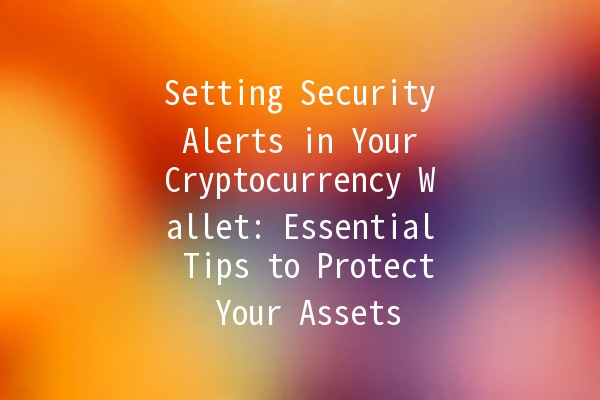
In the everevolving world of cryptocurrency, ensuring the security of your digital assets is paramount. One effective way to enhance security is by setting up alerts within your cryptocurrency wallet. Alerts can notify you of various activities, keeping you informed about your wallet's status and potential threats. This article will delve into five practical techniques to set security alerts in your cryptocurrency wallet, ensuring you remain vigilant and proactive.
Why Setting Alerts is Crucial for Your Cryptocurrency Wallet
The increase in cryptocurrency adoption has led to a rise in cyber threats targeting users’ wallets. Cyber attackers often use sophisticated tactics to gain access to wallets and steal funds. Setting up alerts helps you monitor unusual activities, allowing for quick responses to secure your assets.
Available Types of Alerts
Before diving into the techniques, it’s essential to understand the different types of alerts you can set up:
Transaction Alerts: Notifies you of every transaction initiated from your wallet.
Balance Alerts: Informs you when your wallet balance drops below a certain threshold.
SignIn Alerts: Alerts you when an unauthorized access attempt is made to your account.

Key Benefits of Setting Up Alerts
Five Techniques for Setting Security Alerts
Description:
Twofactor authentication adds an extra layer of security to your wallet by requiring a second form of verification in addition to your password.
Practical Example:
Most wallets support 2FA through apps like Google Authenticator or SMS verification. When logging in, you enter your password and then provide a code sent to your phone or generated by an app. This ensures that even if your password is compromised, your wallet still remains secure.
Implementation Tips:
Choose a reputable 2FA app.
Backup your 2FA codes securely to avoid lockout.
Description:
Many cryptocurrency wallets have builtin security features that allow users to set custom alerts.
Practical Example:
If your wallet supports it, configure alerts for specific transactions. For instance, you can be notified each time a transaction exceeds a certain amount, or every time a fund is sent to an external address.
Implementation Tips:
Review your wallet’s security settings regularly.
Enable alerts for multiple types of transactions to maximize vigilance.
Description:
Email notifications are a straightforward way to receive alerts about your wallet activity.
Practical Example:
Most wallet providers allow you to receive emails for any signin activity or transaction initiation. For instance, if your wallet provider detects an unusual login attempt, you will receive an instant email notification.
Implementation Tips:
Ensure that the email account linked to your wallet is secured with 2FA.
Regularly check your email settings to ensure notifications are turned on.
Description:
Use blockchain explorers to keep track of your wallet transactions independently.
Practical Example:
Input your wallet address on a blockchain explorer like Etherscan or Blockchair. Customize alerts through these services to be notified whenever a transaction is recorded involving your wallet.
Implementation Tips:
Be familiar with how to use blockchain explorers, and look out for suspicious addresses interacting with your wallet.
Regular checks can help you spot unauthorized transactions quickly.
Description:
Consider integrating thirdparty security tools designed to monitor your wallet for unauthorized transactions or potential breaches.
Practical Example:
Services like Crystal or CipherTrace can analyze wallet activities and provide alerts based on unusual patterns, such as sudden spikes in spending or connections to known malicious actors.
Implementation Tips:
Opt for reputable services with good reviews.
Regularly update these tools and subscribe to their alert systems.
Frequently Asked Questions
Answer:
If you receive an alert, immediately log into your wallet and review your transaction history. If something looks unusual, consider transferring your remaining funds to a new wallet address. You can also contact your wallet’s customer support to report the activity.
Answer:
While SMS is better than having no 2FA, it's not as secure as an authentication app. SMS can be vulnerable to attacks like SIM swapping. It's advisable to use apps like Google Authenticator or Authy for better security.
Answer:
Yes, most wallet providers will allow you to set up alerts for each wallet individually. Ensure you manage each wallet's security settings separately to receive comprehensive coverage.
Answer:
It's best to check your wallet at least once a week. However, if you have security alerts set up, checking more frequently can provide extra peace of mind.
Answer:
Most wallets will have a recovery process. This often involves using security questions, backup phrases, or other recovery methods. Ensure you keep backup and recovery information safe.
Answer:
No, not all wallets have builtin alert systems. Always check the features before choosing a wallet. It’s wise to select wallets that prioritize security and user notifications.
By employing these techniques, you can significantly enhance the security of your cryptocurrency wallet and protect your digital assets. Vigilance and proactive measures are key in the world of cryptocurrencies, where the stakes are high, and threats can be real. With the right alerts in place, you can confidently manage your digital investments.

